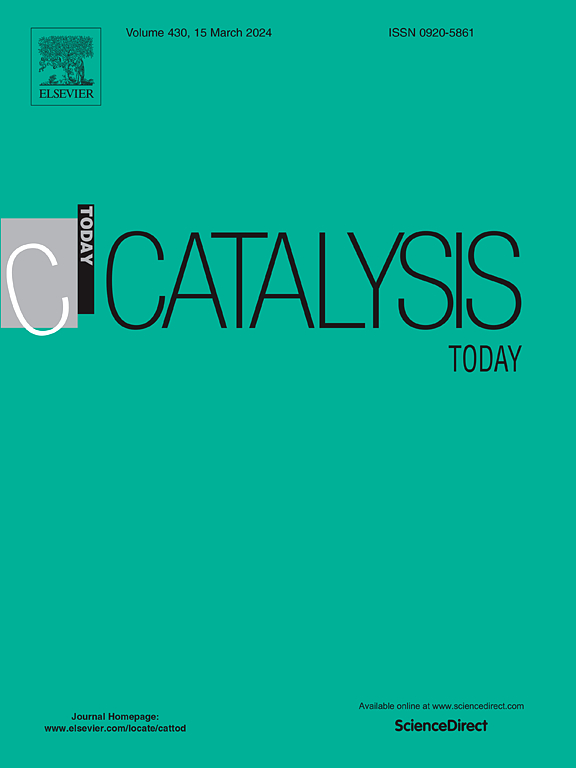Enhanced photocatalytic CO2-to-CH4 conversion through K+-ion induced crystallization of carbon nitride
IF 5.2
2区 化学
Q1 CHEMISTRY, APPLIED
引用次数: 0
Abstract
The photocatalytic reduction of CO2 to methane using carbon nitride holds significant promise for sustainable fuel production; however, its performance remains limited due to the poor crystallization of pristine carbon nitride (PCN). In this study, KCl and KBr were used as templates to prepare crystalline carbon nitride (CCN). The results showed that K+ ions promoted the formation of CCN by intercalating into the structure, reducing the exposure of terminal amino groups, and significantly improving the photocatalytic CO2-to-CH4 conversion efficiency, which increased from less than 5 % in K-free melamine-based PCN (CN-M) to 41 % in CCN-MBr (sample prepared with KBr) and 53 % in CCN-MCl (material synthesized with KCl), respectively. Similar improvements were obtained in dicyandiamide-derived PCN (CN-D) and CCN samples (CCN-DBr and CCN-DCl, prepared with KBr and KCl, respectively). The incorporation of K+ into the tri-s-triazine structure played a pivotal role in charge separation, while the reduced exposure of amino groups lowered the band gap of the material. In situ diffuse reflectance infrared Fourier transform spectroscopy (DRIFTS) was used to identify intermediates during photocatalytic CO2 reduction. Density functional theory (DFT) calculations showed that the Gibbs free energy for *CHO formation decreased from 0.80 eV (PCN) to 0.53 eV (CCN), favoring methane production over CCN. This study lays the foundation for further research on selective CO2 reduction to produce hydrocarbon fuels.
通过K+离子诱导氮化碳结晶增强光催化CO2-to-CH4转化
利用氮化碳将二氧化碳光催化还原为甲烷,对可持续燃料生产具有重大意义;然而,由于原始氮化碳(PCN)结晶性差,其性能仍然受到限制。本研究以KCl和KBr为模板制备了结晶氮化碳(CCN)。结果表明,K+离子通过嵌入结构促进了CCN的形成,减少了末端氨基的暴露,显著提高了光催化co2到ch4的转化效率,从无K三聚氰胺基PCN (CN-M)的不到5 %提高到CCN- mbr (KBr制备的样品)的41 %和CCN- mcl (KCl合成的材料)的53 %。双氰胺衍生的PCN (CN-D)和CCN样品(分别由KBr和KCl制备的CCN- dbr和CCN- dcl)也得到了类似的改进。K+加入到三-s-三嗪结构中对电荷分离起关键作用,而氨基暴露的减少降低了材料的带隙。采用原位漫反射红外傅立叶变换光谱(DRIFTS)对光催化CO2还原过程中的中间体进行了鉴定。密度泛函理论(DFT)计算表明,*CHO生成的吉布斯自由能从0.80 eV (PCN)降低到0.53 eV (CCN),有利于甲烷的生成。本研究为进一步开展选择性CO2还原生产碳氢燃料的研究奠定了基础。
本文章由计算机程序翻译,如有差异,请以英文原文为准。
求助全文
约1分钟内获得全文
求助全文
来源期刊

Catalysis Today
化学-工程:化工
CiteScore
11.50
自引率
3.80%
发文量
573
审稿时长
2.9 months
期刊介绍:
Catalysis Today focuses on the rapid publication of original invited papers devoted to currently important topics in catalysis and related subjects. The journal only publishes special issues (Proposing a Catalysis Today Special Issue), each of which is supervised by Guest Editors who recruit individual papers and oversee the peer review process. Catalysis Today offers researchers in the field of catalysis in-depth overviews of topical issues.
Both fundamental and applied aspects of catalysis are covered. Subjects such as catalysis of immobilized organometallic and biocatalytic systems are welcome. Subjects related to catalysis such as experimental techniques, adsorption, process technology, synthesis, in situ characterization, computational, theoretical modeling, imaging and others are included if there is a clear relationship to catalysis.
 求助内容:
求助内容: 应助结果提醒方式:
应助结果提醒方式:


